


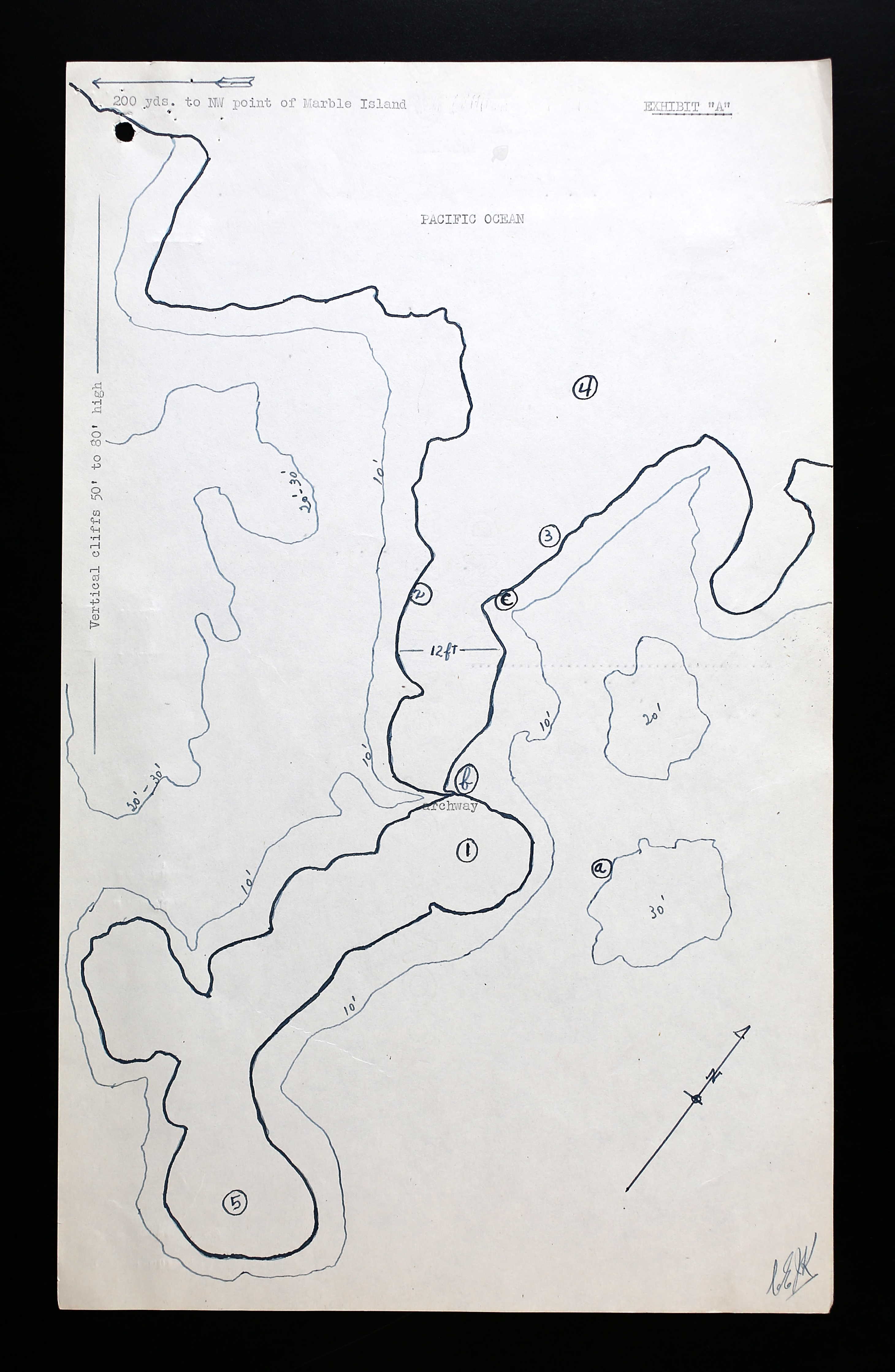
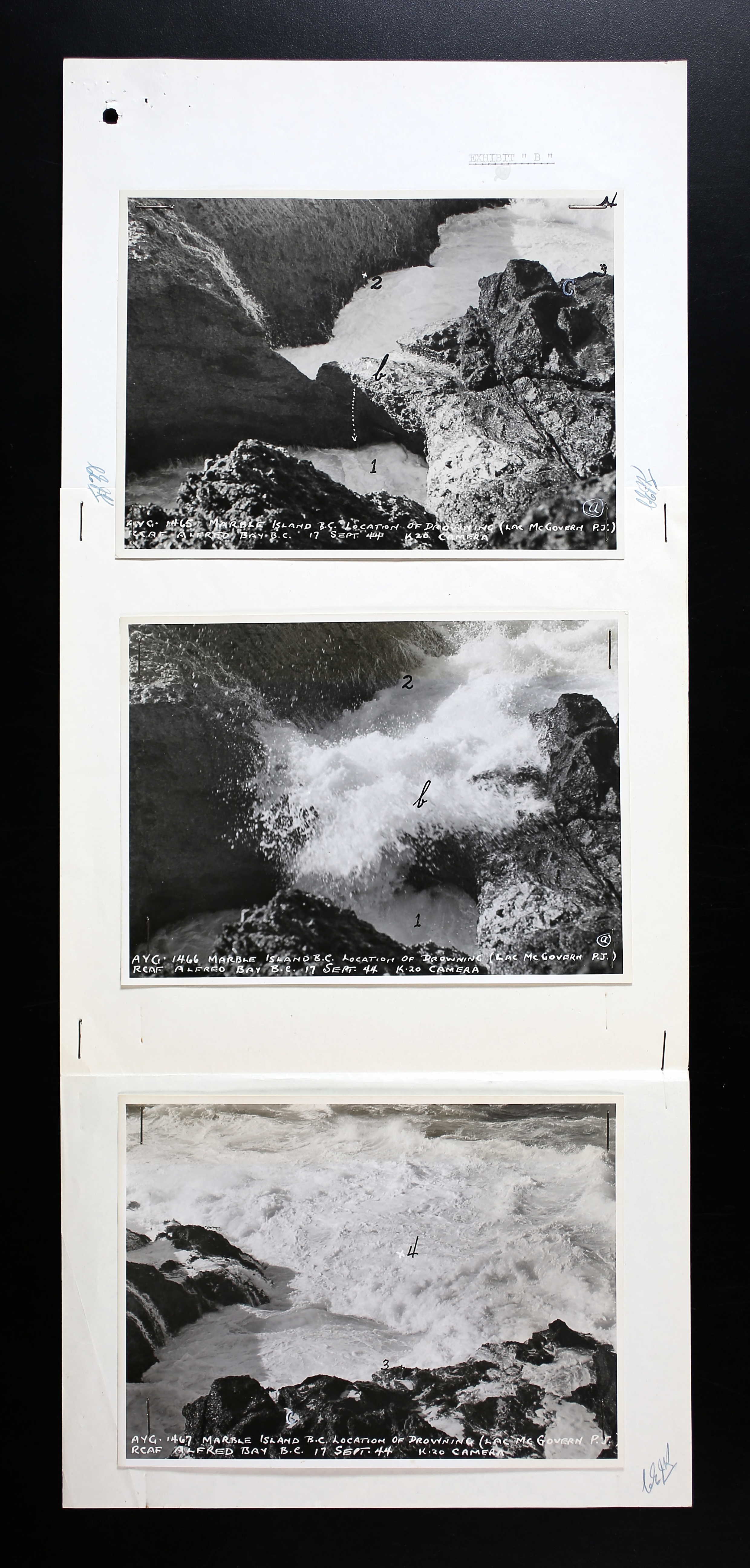
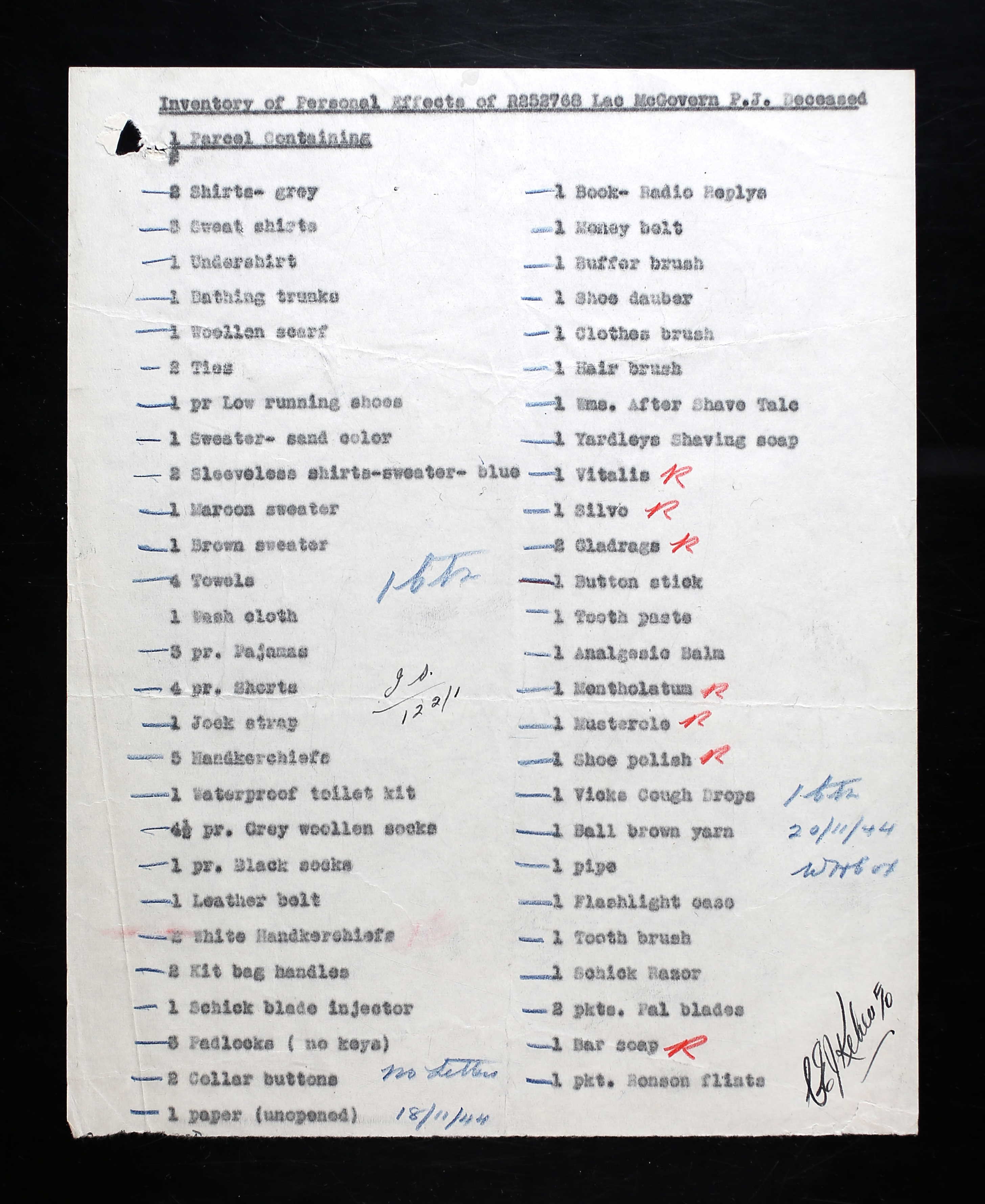
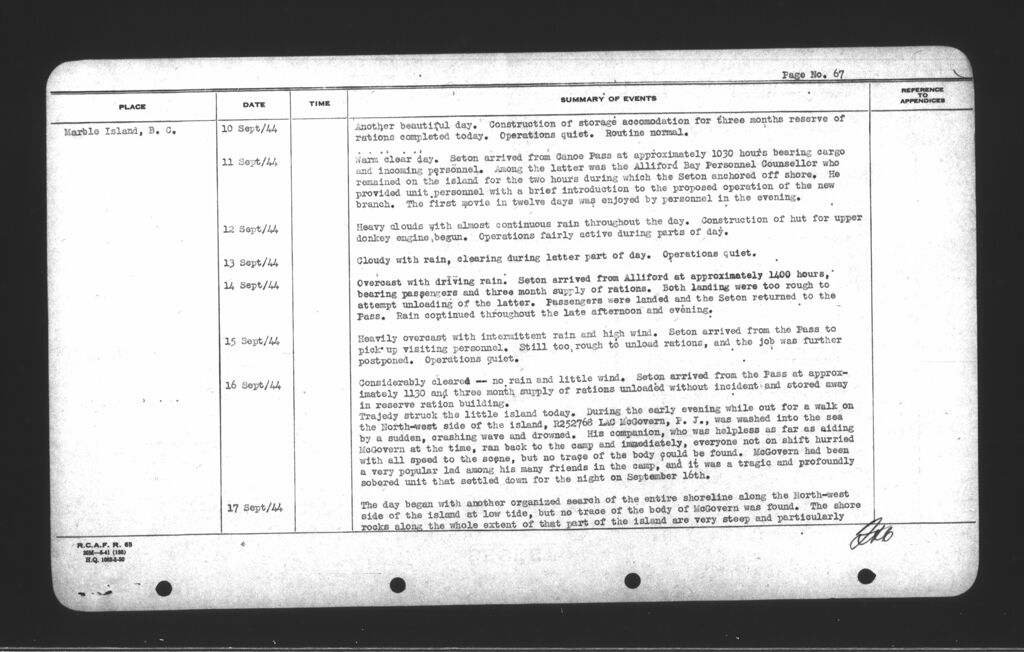
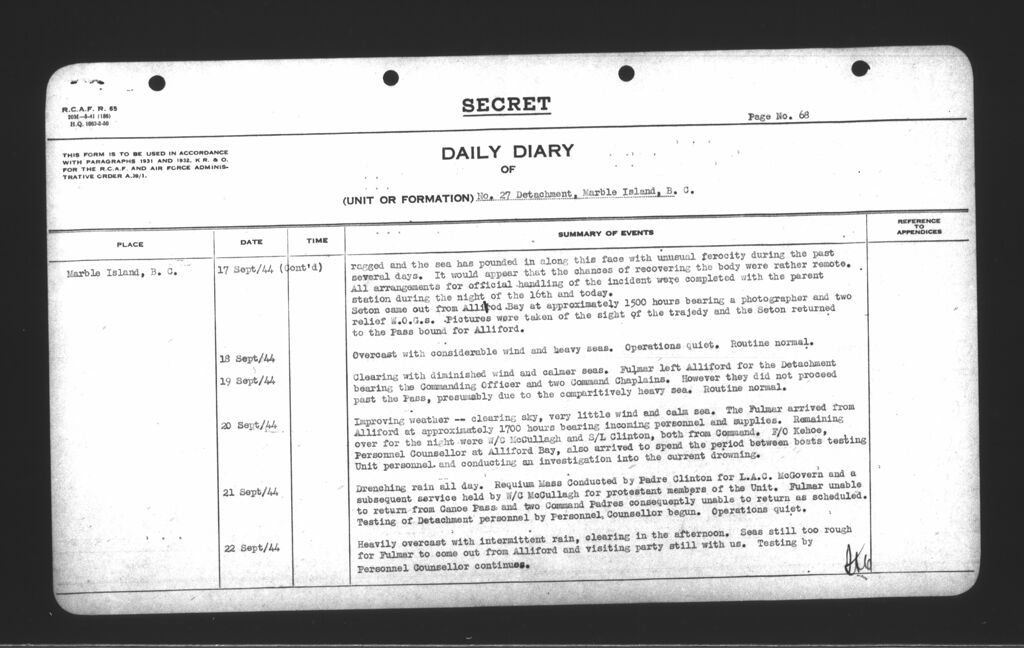
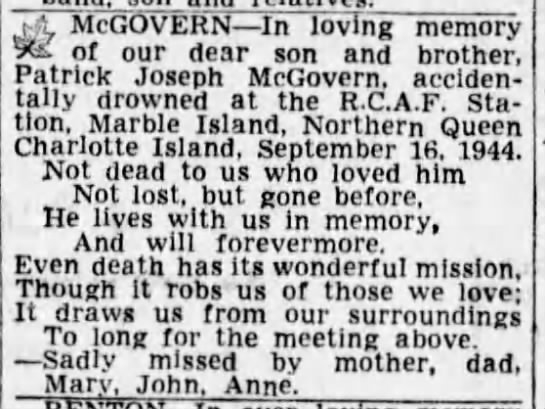
March 6, 1924 - September 16, 1944









Patrick Joseph McGovern was born in Vancouver, British Columbia to Michael Thomas McGovern and his wife, Anna Marie (nee Dunne) McGovern. Patrick had one brother and two sisters. His brother, John James, was serving at HMCS Discovery. His sisters, Mary Kathleen and Margaret Anne both lived at home. The family was Roman Catholic.
Prior to enlistment at No. 1 Recruiting Centre, Vancouver, Pat had worked at Safeway’s as a grocery clerk.
He joined the RCAF in April 1943. He had listed basketball, football, badminton, tennis, skiing and bowling as sports he engaged in. He liked to build model aircraft. He thought he would be best qualified to do ground duties as a Wireless Operator.
He stood 6’ tall and weight 162 pounds. He had a medium complexion, blue eyes and brown hair.
Pat was sent to No. 3 RD, Vancouver until the end of August 1943, when he was sent to No. 3 Manning Depot in Edmonton, Alberta until November 3, 1943. Travelling east to Quebec November 4th, he began his training as a Ground Wireless Operator at No. 1 Wireless School in Montreal, Course 45 on November 8th, 1943, graduating February 5th, 1944. He earned 100% in Morse Code, but struggled on the radio apparatus and installation and maintenance, plus radio principles and operating. He earned an overall 66.4%, passing the course, with an average assessment. He was 39th out of 48 in the class. While there, he was at the station hospital with pneumonia for eight days in November 1943.
Returning to Vancouver February 6, 1944, he remained there for about two weeks before he was posted to RCAF Station Alliford Bay, BC, which is located in the Haida Gwaii, formerly known as the Queen Charlotte Islands. On August 2, he was posted to No. 27 Detachment, Marble Island, a boat ride away from Alliford Bay, earning $2.00 per day.
On September 16, 1944, while off duty, he drowned.
A Court of Inquiry was struck and held on September 22 and 23, 1944 in the office of the Officer Commanding No. 27 Detachment, Marble Island, BC.
The first witness, LAC Leonard Evans, Wireless Operator Ground, B Group, employed in the Signals Section of No. 27 Detachment, Marble Island, BC stated: "In the company with LAC McGovern, I left camp at approximately 1900 hrs. Saturday 16th of September. We strolled along the shore arriving at point A as shown on Exhibits A and B attached to this report, at about 1920 hrs. He proceeded down to point B and twice we noticed waves approaching and breaking very close to the archway. Each time he retreated to a safer place, but returned to the archway as the waves receded. I noticed a large waves coming and I yelled at him. He looked out to sea and immediately turned around. He had taken about two steps when the weight broke over the archway and swept him into the whirlpool at position number one. The receding wave drew him through the archway out towards the sea. For a moment, he clung to the sea growth along the wall at point 2, then started to swim quite strongly up the future towards the archway. Another wave broke over him and he must’ve been knocked unconscious for when the waves were seated, I noted him floating with face underwater and hands clasped behind his head at about position three. I next saw him and a heavy swirl at position 4. He then disappeared and I did not see him again. When this first wave hit him and swept him into the pool, I was sitting and I immediately rushed to a location, which was about 5 feet above the water, in hopes that I might have a chance of getting a hold of him. Due the perpendicular walls, I was unable to get anywhere near the water. While I was in the same position, a wave swept over him and broke just on my hips and pressed me back against the seaward side of the rock. The shore drops off perpendicularly for about 6 feet all along both sides of the fissure and it was impossible to get near the water at any point. I remained in the immediate vicinity for about five minutes and then ran back to notify the officer commanding of what happens. With about 15 men, we have once return to the scene and looked around hoping to gain sight of the body. While there, we discovered is Floating on the water. Endeavors are made to retrieve the cat but it was washed out to see before we were able to do so. We remained until about 2030 or 2045 hrs. It was almost dark, and then we return to camp. We went out the next morning, about 20 of us, to search for the body. Everyday there has in some out searching on all sides of the island but to no avail. The body has not been found." LAC Evans stated that other airmen on the station had crossed the archways, possibly two that he knew of. He added that LAC McGovern was one of them, as he told Evans he had. He admitted that he told McGovern, “You are not going to cross there, are you, Pat?” McGovern’s response was, “Sure, I’ve done it before.”
The second witness, F/O F. E. Glover, Radar Officer, No. 27 Detachment, Marble Island, BC stated: "On the evening of September 16, 1944, I was reading in the quarters when LAC Evans ran into the room completely out of breath and obviously in a state of high excitement. With considerable difficulty, he told me that he believed Pat McGovern has been drowned. I pause long enough to get from him a few intelligible details, then ran across to the recreational hall to round up some of the men. I encountered several, told them to standby, and went in search of D/O F. A. Campbell, whom I found immediately, just coming out of the mess. I explained briefly to him what had happened in within a matter of seconds, he and I together with a considerable number of men including LAC Evans were on our way over the rocks with light preservers and ropes. I estimate the time elapsed between Evans’s disclosure of the accident and our departure from the camp area and not more than a minute and a half. We arrived at the scene and I noted at that time, that’s it was just short of 8 o’clock. it had taken us perhaps 10 to 12 minutes to reach the point close to the northwest corner of the island. We stayed grouped around the scene for a considerable time, searching to see in the immediate area and the adjacent shoreline, but no trace of the body was found. During the period referred to, someone discovered the winter hat the airman was wearing floating in one of the inner pools indicated on the map. An effort was made to retrieve it, but it was eventually considered to be too dangerous and abandoned. Finally after coming to the conclusion that nothing further to be done there, we started back toward the camp, hugging the shoreline wherever possible. A thorough search was pressed until darkness forced us to stop. The following morning, all detachment personnel not on shift returned to the scene at an early hour when the tide was low, and hope that the body might have been washed up on the rocks during high tide of the proceeding night. A thorough search was again made of the entire shoreline, but despite the more favorable type of condition, our efforts proved equally fruitless. It was considered at this point that the only possible chance of retrieving the body within the next few days late and it’s being washed up in cost among the rocks at an accessible part of the shoreline. But this often mine, a periodic search of the entire face of the island adjacent to the scene of the accident, has been exercised, but to this date with no success. The only time the body was seen in the waters at the time of the accident and by Evans. Under the sea condition obtaining at the time, I would consider it to be utterly impossible without immediate assistance–– Immediate, meaning within seconds –– and then, only if the men were not washed out of reach of the short into the boiling surf. The effectiveness of placing certain areas of the island out of bounds would be highly theoretical. The newcomers on the island with the spectacle of plunging surf holds for them a certain fascinating allure and the absolute prohibition of sorties along the rocks would be extremely difficult, and I am afraid, any factual. I believe the best insurance against the repetition is the prominent posting within the Area of vivid warnings against the treacherous list of all sections of the immediate shoreline especially in times of heavy seas and urging the use of utmost caution when exploring any part of its extent. This measure, in fact, is being carried out. McGovern was not on duty at the time of the accident."
The third witness, Cpl. G. B. Dodge, Chef A Group, employed at the Mess at No. 27 Detachment, Marble Island stated: "F/O Campbell and I were discussing rations in the mess hall at about 1915 hrs. on Saturday, September 16, when Mr. Glover came into the mess and said that Pat McGovern was drowning. We ran out of the mess hall and it’s the recreation Hall and called to all the men in there that someone was drowning. Then we all followed Evans out the location with a tragedy occurred. It took us about 10 minutes to get out there. To the fellows picked up life preservers and ropes on the way. Shortly after, we saw a hat floating around in the pool. It was a winter hat. Pat was the only person wearing a winter hat in this mess for the past two weeks. We tried to get out of that were not successful and I was washed out to the ocean. We stayed until it was dark. The boys worked up and down the cliffs looking for signs but finding none. We later came back to camp at dusk about 2100 hrs. Next morning on Sunday, at daybreak, we formed several search parties and I went to the northeast end of the Island. Nothing was found. I worked Monday but other boys went out searching in on Tuesday afternoon I went out again, all afternoon until 1700 hrs. Many of us have been out everyday since but have found nothing. I would suggest that as long as young fellows are daring, they will take chances. A talk to each new man when he first arrives morning him of the dangers might help. Warning signs could also be used to help prevent accidents of this type.
FINDINGS by F/O C. E. J. Keho, Investigating Officer, September 23, 1944: "That the accident was caused to by a large wave washing the deceased into the turbulent water of a deep, rocky cut, where he was dashed against the surrounding rocks, and drowned in the boiling undercurrents. The deceased was not duty at the time of his death. The deceased what’s himself, guilty of a foolhardy act in venturing out onto the ledge, as it was wholly unnecessary to cross at this point, with other safer and more favorable crossings being readily available. There is no evidence to substantiate responsibility or negligence on the part of any other individual or group.
From the Station Diaries: 16 Sep 44 Considerably cleared - no rain and little wind. Seton arrived from the Pass at approximately 1130 hours and three months supply of rations unloaded without incident and stored away in reserve ration building. Tragedy struck the little island today. During the early evening while out for a walk on the North-west side of the island, R252768 LAC McGovern, PJ, was washed into the sea by a sudden, crashing wave and drowned. His companion, who was helpless as far as aiding McGovern at the time, ran back to the camp and immediately everyone not on shift hurried with all speed to the scene, but no trace of the body could be found. McGovern had been a very popular lad among his many friends in the camp, and it was a tragic and profoundly sobered unit that settled down for the night on September 16th.
17 Sep 44 The day began with another organized search of the entire shoreline along the North-west side of the island at low tide, but no trace of the body of McGovern was found. The shore rocks along the whole extent of that part of the island are very steep and particularly ragged and the sea has pounded in along with unusual ferocity during the past several days. It would appear that the chances of recovering the body were rather remote. All arrangements for official handling of the incident were completed with the parent station during the night of the 16th and today. Seton came out from Alliford Bay at approximately 1500 hours bearing a photographer and two relief WOG's. Pictures were taken of the site of the tragedy and then Seton returned to the pass, bound for Alliford.
Pat was presumed dead on February 21, 1945, as his body was never recovered.
In late October 1955, Mrs. McGovern received a letter from W/C Gunn telling her that her son’s name would appear on the Ottawa Memorial, as he had no known grave.